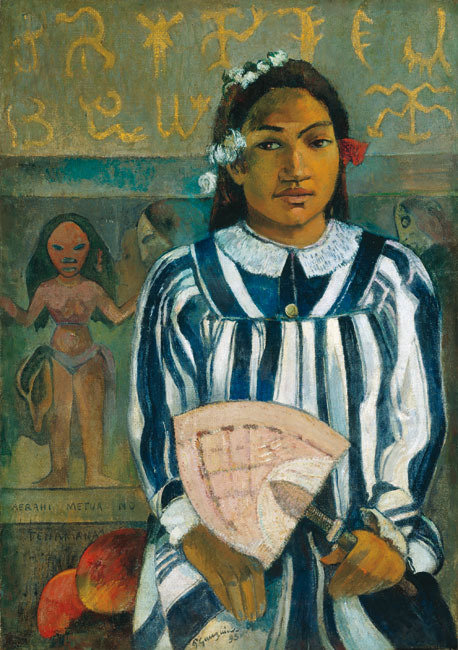Gauguin
dal 29/9/2010 al 15/1/2011
Segnalato da
29/9/2010
Gauguin
Tate Modern, London
For the first time in the UK in over 50 years, Tate Modern presents an exhibition dedicated to this master French Post-Impressionist, featuring paintings and drawings from around the world. His sumptuous, colourful images of women in Tahiti and beautiful landscape images of Brittany in France are some of the most popular images in Modern art. The exhibition explores the role of the myths around the man - Gauguin as storyteller, painting himself as a Christ-like figure or even a demon in his own paintings, religious and mythical symbols in his work, and the manipulation of his own artistic identity.

Gauguin (1848-1903) is one of the most influential and celebrated artists of the late nineteenth century. Remarkably, this is the first major exhibition in London to be devoted to his work in over half a century. Opening at Tate Modern on 30 September 2010, Gauguin: Maker of Myth will trace the artist’s unique approach to storytelling. Bringing together over 100 works from public and private collections from around the world, the exhibition will take a fresh and compelling look at this master of modern art.
A Post-Impressionist and a pioneer of modernism, Gauguin’s powerful and bold images were seen as radical as he distanced himself from the influence of Impressionism. Gauguin’s life has for generations epitomised the idea of the artist as romantic bohemian, looming as large as his art in the public imagination. This exhibition will challenge commonly held assumptions about the artist and his practice. It will reveal to a twenty-first century audience the complexity and richness of his narrative strategies and explore the myths and fables that were central to his creativity.
Gauguin: Maker of Myth will feature many of his iconic works including Vision of the Sermon 1888 (National Gallery of Scotland), inspired by Brittany, and Teha’amana has Many Parents 1893 (Art Institute of Chicago), painted during his time of self-imposed exile in Tahiti. Gauguin sought to escape European civilisation in the South Seas. Inspired by Tahiti’s tropical flora, fauna and daily island life he also immersed himself in its fast-disappearing local culture to invest his art with deeper meaning, ritual and myth. While Tahiti revitalised Gauguin’s artistic oeuvre, the works were a continuation of his earlier practice in Brittany, Martinique and Arles, in which Gauguin first explored ideas around religion, fable, myth and tradition.
A highlight of the exhibition will be a room dedicated to his self portraits such as Self-portrait as Christ in the Garden of Olives 1889 (Norton Museum of Art, Florida) and Self-portrait with Manau tu papau 1893 (Musée d’Orsay, Paris). These works demonstrate Gauguin’s aptitude at role-playing as he adopts different guises of victim, saint, Christ-like martyr and sinner.
Gauguin: Maker of Myth reflects the artist’s remarkable breadth of approach by including examples from every period of his practice. Works in a wide range of media from painting and watercolour to ceramics, carvings and decorated objects will be shown alongside rarely-seen illustrated letters, sketchbooks, memoirs and journalism, revealing intimate insights into the artist’s working practices and thought processes.
Gauguin: Maker of Myth is curated by Belinda Thomson, an art historian and leading specialist on Gauguin, Christine Riding, Curator, Tate, and Amy Dickson, Assistant Curator, Tate Modern, with Tamar Garb as an external consultant. Gauguin: Maker of Myth is organised in collaboration with the National Gallery of Art, Washington where the exhibition will travel from 21 February – 30 May 2011. The exhibition is accompanied by a fully illustrated catalogue which includes essays from leading international scholars.
Eugène Henri Paul Gauguin was born in Paris and spent his early childhood in Peru. Joining the merchant navy at seventeen he travelled for six years, visiting South America, Scandinavia and other parts of the globe. In 1871 he joined a Paris stock broking firm and in 1873 married a Danish woman, painting in his spare time. In 1883, with five children to support, he resigned from his job, determined to pursue an artistic career. From 1886, separated from his family, Gauguin became increasingly disenchanted with Paris and worked mainly in Brittany, with influential spells in Martinique and Arles. After leaving Europe for Tahiti in 1891, apart from two further years in France, the remainder of his life was spent in the South Seas.
Image: Teha 'amana has many parents 1893. Photo: © The Art Institute of Chicago enlarge
For further information contact Daisy Mallabar/Bomi Odufunade, Tate Press Office, Millbank, London SW1P 4RG Call 020 7887 8731/4942, Email pressoffice@tate.org.uk
Tate Modern
Bankside, London SE1 9TG
Opening hours
Sunday – Thursday, 10.00–18.00
Last admission to special exhibitions at 17.15
Friday – Saturday, 10.00–22.00
Last admission to special exhibitions at 21.15



